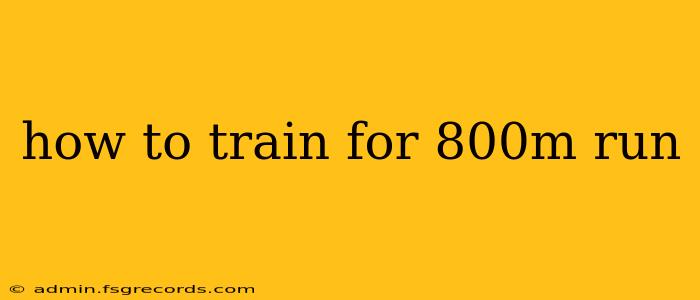The 800m run is a grueling test of speed and endurance, demanding a unique training approach. It's not a pure sprint, nor is it a pure distance race; it sits in that challenging middle ground requiring a balance of speed work, stamina building, and strategic recovery. This guide will walk you through a comprehensive training plan to help you achieve your 800m goals, whether you're a seasoned runner looking to improve your time or a beginner aiming to complete the race.
Understanding the 800m: Speed and Endurance
The key to 800m success lies in the ability to maintain a high pace for an extended period, requiring both anaerobic and aerobic fitness. Unlike a 400m sprint, which relies heavily on anaerobic power, the 800m necessitates a significant aerobic base to prevent early fatigue. Your training needs to reflect this duality.
Phase 1: Building a Strong Aerobic Base (8-12 Weeks)
This initial phase focuses on developing your cardiovascular endurance and laying the foundation for speed work. Consistency is paramount here.
Key Training Elements:
- Easy Runs: These form the backbone of your training. Aim for 3-4 easy runs per week, lasting 30-60 minutes at a conversational pace.
- Tempo Runs: These involve sustained efforts at a comfortably hard pace, typically lasting 20-40 minutes. Tempo runs improve your lactate threshold – the point at which lactic acid builds up in your muscles.
- Long Runs: One long run per week is crucial. Gradually increase the distance over time, aiming for 45-75 minutes at an easy pace. This builds your endurance and stamina.
- Cross-Training: Incorporate activities like swimming or cycling 1-2 times per week for active recovery and to improve overall fitness without stressing your running legs.
Phase 2: Speed Development (6-8 Weeks)
Once you have a solid aerobic base, it’s time to focus on speed development.
Key Training Elements:
- Interval Training: This is the cornerstone of 800m training. Focus on intervals ranging from 200m to 400m, with recovery periods in between. The faster the interval pace, the shorter the recovery should be. Experiment with different interval structures (e.g., 6 x 400m, 8 x 200m) to find what works best for you.
- Repetition Training: Similar to intervals, but with shorter recovery periods. Repetition training improves your speed and ability to tolerate lactic acid build-up. Examples include 10 x 100m or 6 x 200m.
- Fartlek Training: This involves varying your pace during your run, incorporating bursts of speed and periods of recovery. It's a great way to improve your speed and endurance without the rigidity of structured intervals.
Phase 3: Race Preparation (4 Weeks)
This phase involves tapering your training volume and focusing on sharpening your race pace.
Key Training Elements:
- Reduced Mileage: Gradually reduce your overall running volume to allow your body to recover and store energy.
- Race-Pace Workouts: Include workouts that mimic your target race pace, such as 800m repeats at your desired time, or even a shorter time trial.
- Rest and Recovery: Prioritize sleep, nutrition, and active recovery to ensure you're fully prepared for race day.
Nutrition and Recovery
Fueling your body correctly is as important as the training itself. Focus on a balanced diet rich in carbohydrates for energy, protein for muscle repair, and healthy fats. Hydration is also crucial, particularly during and after your workouts.
Adequate rest and recovery are vital to prevent injury and overtraining. Listen to your body and don't hesitate to take rest days when needed.
Sample Weekly Training Schedule (Phase 2):
This is a sample schedule and may need adjustments based on your fitness level and experience.
Monday: Rest or Cross-Training Tuesday: Easy Run (45 minutes) Wednesday: Interval Training (6 x 400m with 400m recovery jog) Thursday: Easy Run (30 minutes) Friday: Strength Training (focus on core and legs) Saturday: Long Run (60-75 minutes) Sunday: Rest or Easy Run (30 minutes)
Remember, consistency and proper pacing are key to success. Listen to your body, adjust your training as needed, and enjoy the process of improving your 800m performance. Good luck!

